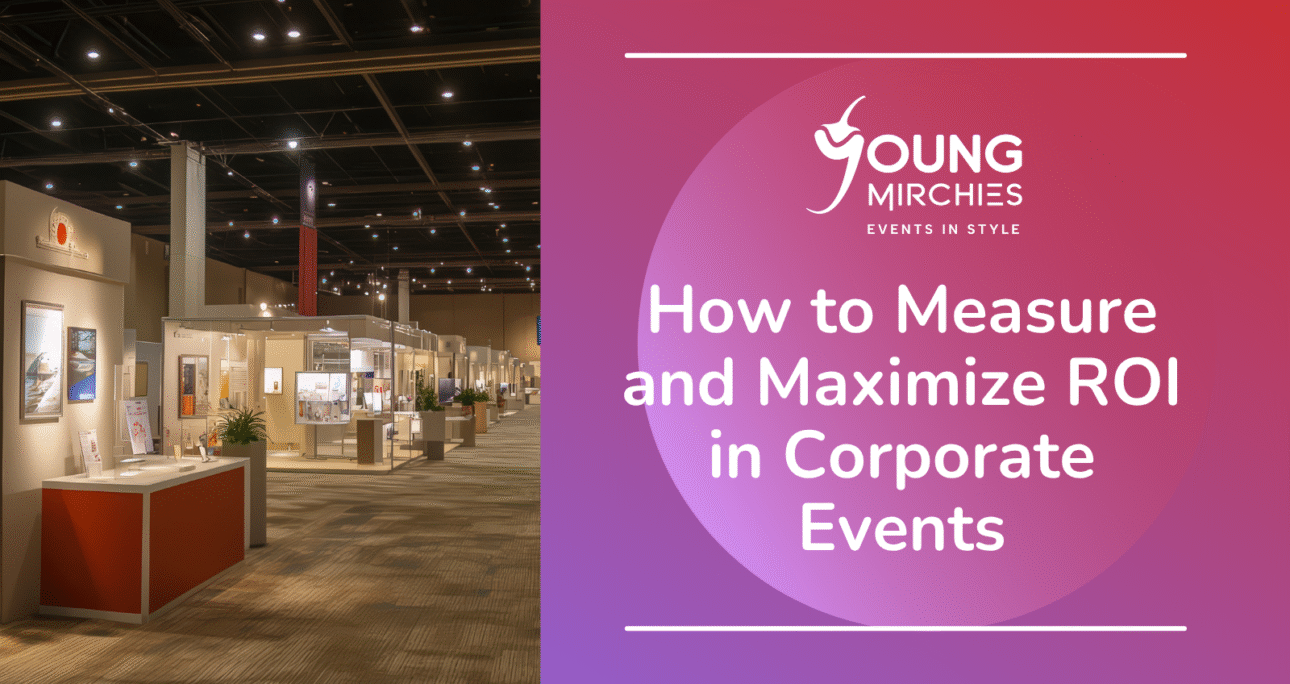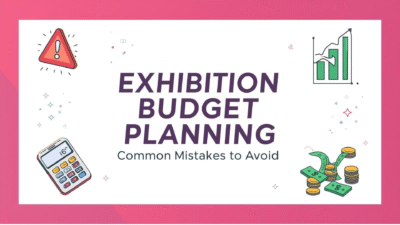Events are powerful tools, used to launch brands, inspire teams, retain clients, and grow businesses. But too often, the success of an event is measured by applause, aesthetic photos, or feel-good moments. While those are great, they don’t justify the investment.
In today’s results-driven business landscape, event ROI (Return on Investment) must be clearly defined, measured, and communicated. This guide offers a step-by-step approach to event planning, executing, and evaluating corporate events that deliver measurable results—not just applause.
Why Measuring Event ROI Is Non-Negotiable for Corporate Success
Corporate events are no longer standalone activities, they are an extension of your business strategy. Whether you’re hosting an employee offsite, leadership summit, brand activation, or client engagement program, your stakeholders expect impact that can be tracked and reported.
Benefits of an ROI-Focused Event Strategy
Aligns the Event With Business Objectives
When event ROI is the anchor, the event stays focused on what matters, growth, engagement, or strategic alignment.
Strengthens Budget Justification
A measurable ROI helps secure approvals for future events and proves that events aren’t cost centres but growth drivers.
Improves Event Planning Discipline
When ROI becomes a KPI, every element, content, design, invitees, speakers, is selected based on its contribution to measurable outcomes.
Define Success: Set Measurable Event ROI Goals
A successful event begins with a clearly defined purpose. If you can’t define success, you can’t measure it.
Clear goals are the foundation of any ROI-driven event strategy.
How to Set Impactful Event Goals
Link Objectives to Business Strategy
Is your goal to acquire new customers, improve retention, motivate employees, or build brand equity? Each needs a different event design and measurement model.
Make Goals Quantifiable
Avoid vague goals like “increase engagement.” Instead, define measurable KPIs such as “generate 150 marketing-qualified leads” or “improve eNPS score by 15 points.”
Align Stakeholder-Specific Goals
HR might target employee satisfaction, while marketing focuses on social media engagement and brand visibility. Align these to ensure collective success.
Match Event Format to ROI-Driven Outcomes
The format of your event should directly support your objectives. A poorly chosen structure can dilute the intended impact even if the execution is flawless.
Examples of Event Formats and Their ROI Potential
Product Launches and Brand Activations
Ideal for visibility and buzz. Measure ROI via media reach, impressions, and engagement metrics.
Workshops and Masterclasses
Perfect for learning, internal alignment, or skill development. Measure success through post-event assessments and implementation rates.
Employee Offsites and Internal Summits
Designed to engage and retain teams. ROI reflects in eNPS, retention rates, and productivity uplift.
CXO Roundtables or Client Dinners
Ideal for deepening relationships with high-value clients. Track ROI via pipeline influence and revenue growth over time.

Event ROI Metrics: Choose the Right KPIs for Each Event
Not all events generate direct revenue. The key is to select event ROI metrics aligned with your event’s purpose and audience.
Lead Generation Events
- Qualified Leads Captured: How many decision-makers or high-intent prospects attended?
- Lead-to-Opportunity Conversion Rate: What percentage of leads progressed to proposals?
- Cost Per Lead: Total spend ÷ number of leads.
Employee Engagement Events
- Pre/Post eNPS: Measure employee sentiment before and after the event.
- Participation Rates: A 95% attendance rate signals relevance and engagement.
- Retention or Productivity Uplift: Track changes over 3–6 months.
Brand Building Events
- Social Mentions & Hashtag Reach: Use tools like Brand24 or Sprout Social.
- Media Coverage & PR Reach: Compare earned media value to paid ads.
- Brand Recall Surveys: Evaluate memory and association post-event.
Client-Facing Events
- Pipeline Influence: Identify deals created or accelerated post-event.
- Client Feedback: Use CSAT or NPS scores.
- Referrals or Upsell Opportunities: Track follow-up conversions.
Strategic Budgeting for Higher Event ROI
An event budget shouldn’t just focus on logistics and design, it should reflect ROI priorities. Think like an investor, not a decorator.
How to Build a Smart, ROI-Centered Budget
Segment Your Spend by Outcome Area
Allocate resources based on ROI goals—lead generation (CRM tools), engagement (activities), and brand elevation (production quality).
Avoid Vanity Spend
A photo booth may go viral, but does it drive ROI? Focus on areas that impact tangible results.
Track Cost per Outcome
Monitor cost per attendee, lead, or impression to understand where your investment pays off.
Drive Engagement to Boost Event ROI Before, During & After
Your event begins the moment the invite goes out and continues well after it ends. Engagement across all stages drives higher ROI.
Engagement Strategies Across the Event Lifecycle
Before the Event
- Send personalized invites and teasers.
- Launch a pre-event microsite or poll.
During the Event
- Use gamification to boost check-ins or attendance.
- Enable live Q&As and interactive sessions.
- Add networking lounges or digital booths.
After the Event
- Share recap videos and highlights.
- Send thank-you emails with next-step CTAs.
- Trigger CRM workflows for lead nurturing.
Integrate Sales, Marketing, and Ops for a Unified ROI Engine
A truly successful event requires cross-functional collaboration. When sales, marketing, and operations work in sync, ROI multiplies.
How to Ensure Cross-Functional Alignment
- Pre-Event Alignment Calls: Sync goals and audience personas.
- Live CRM Integration: Capture real-time attendee data.
- Content Handoff: Share presentations, Q&As, and demos with sales for re-engagement.
Event ROI Tools and Technology for Data-Driven Measurement
Technology simplifies tracking and reporting. Automating event ROI measurement ensures accurate insights and faster action.
Tools That Drive ROI
- Event Platforms: Hubilo, Cvent, Airmeet – for attendance and engagement analytics.
- Feedback Tools: Typeform, SurveyMonkey – for structured event surveys.
- Badge Scanning: QR or RFID tech – to measure booth visits and networking.
- Analytics Dashboards: Google Data Studio or Tableau – for live ROI dashboards.
Post-Event Analysis: The Secret to Sustained Event ROI
The real ROI emerges after the event—through analysis, follow-up, and storytelling.
What to Do Immediately After the Event
- Internal Debrief (within 3 days): Discuss results, wins, and areas to improve.
- Distribute Reports: Tailor summaries for sales, HR, and leadership.
- Repurpose Content: Convert keynotes into blogs, testimonials into social proof.
Learn From Every Event to Improve ROI Over Time
Event ROI isn’t a one-time effort—it’s a long-term strategy built on learning and optimization.
How to Document and Improve
- Maintain a “Lessons Learned” Sheet: Log what worked and what didn’t.
- Benchmark Results: Compare ROI across similar event types.
- Create an Internal ROI Playbook: Use best practices to train future teams.
Common Mistakes That Lower Event ROI
- Focusing only on aesthetics, not outcomes.
- Ignoring post-event data and analytics.
- Not integrating CRM tools with attendee insights.
- Overlooking long-term impact tracking.
Avoiding these mistakes can instantly improve your event performance measurement and long-term returns.
Frequently Asked Questions (FAQs)
What is a good ROI for a corporate event?
While it varies by event type, most B2B events aim for at least 5x ROI in terms of pipeline or brand value. Internal events use metrics like eNPS or retention improvement.
Can internal events like offsites or town halls have ROI?
Absolutely. Use KPIs such as participation rate, employee satisfaction, and productivity uplift to measure internal event ROI.
What tools help measure event ROI?
Platforms like Cvent, Hubilo, Bizzabo, and Google Analytics (for microsites) help track engagement and ROI.
Should ROI be shared with attendees or just internal teams?
Mostly internal but sharing highlights (media coverage, engagement stats) boosts credibility and future participation.
How soon should post-event ROI be evaluated?
Initial reports should be ready within 3–5 days, while long-term ROI can be analyzed after 30–90 days.
About Young Mirchies
Young Mirchies is a full-service event and experiential agency helping brands design events that are not just memorable—but measurable. From employee offsites and internal summits to trade shows, CXO dinners, and activations, every experience we build is backed by an ROI-first mindset.
Our Services Include:
- Event strategy and goal setting
- End-to-end logistics and execution
- Lead-gen optimized booth and experience design
- Onsite and post-event analytics dashboards
- Sales and marketing integration
If you’re looking to make your next event not just impressive, but impactful—plan smarter, not just louder.
Visit www.youngmirchies.com to get started.



